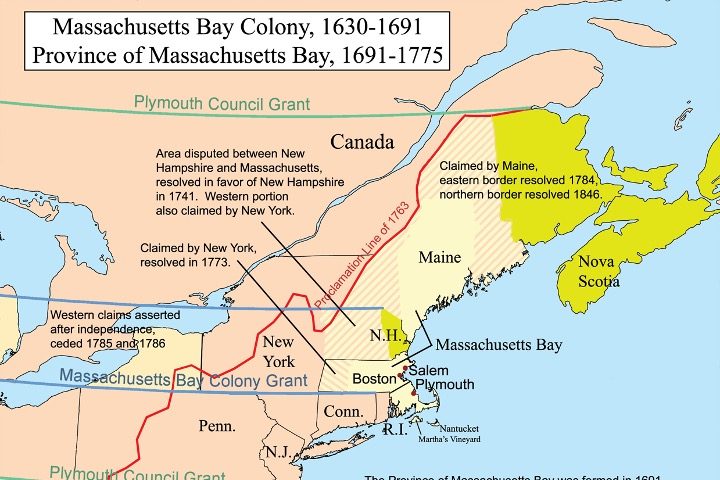
Introduction
On October 7, 1691, a significant event unfolded in the history of Colonial America—the issuance of the charter for the Province of Massachusetts Bay. This charter marked a turning point in the relationship between the Massachusetts Bay Colony and the British Crown, setting in motion a series of events that would ultimately culminate in the American War for Independence. In this article, we will examine briefly the circumstances surrounding the charter’s issuance, its key provisions, and the profound impact it had on the path toward American independence.
The Charter for Massachusetts Bay
1. Background and Context:
The charter for the Province of Massachusetts Bay was granted by King William III and Queen Mary II in response to several factors. First, it aimed to consolidate and reorganize the various colonies in New England, including the Massachusetts Bay Colony, Plymouth Colony, and the territories of Maine and Nova Scotia. Second, it sought to strengthen British control over these colonies, which had, over time, established a degree of self-governance and independence. Lastly, it reflected the desire of the British Crown to exert more control over the New England colonies, both for economic and political reasons.
2. Key Provisions:
The charter of 1691 introduced several critical provisions that would impact the governance and rights of the inhabitants of Massachusetts Bay:
– It established a provincial government with a royal governor appointed by the Crown. This marked a departure from the previous charter of 1629, which had allowed for local self-governance.
– It mandated that all provincial laws, once passed by the colonial legislature (General Court), would be subject to approval by the British Crown.
– The Church of England was formally recognized, signaling a shift away from the Puritan influence that had dominated religious life in the colony.
– Religious freedom was granted to non-Puritan Protestants, which was a significant departure from the religious orthodoxy that had characterized the Massachusetts Bay Colony.
The Impact on Independence
1. Strain on Colonial Autonomy:
The charter of 1691 represented a significant erosion of colonial autonomy and self-governance. The appointment of a royal governor accountable to the Crown introduced a strong British presence in the provincial administration. The requirement for Crown approval of all provincial laws gave the British government substantial control over colonial legislation. This shift was a source of growing tension between the inhabitants of Massachusetts Bay and the British authorities.
The establishment of nearly daily and direct dependence on royal accession for colonial governance did not go unnoticed by colonists. This was a people already prone to pointing out that there was no King but Christ, and to have divine primacy challenged by the civil authority was to create irreparable enmity between the Crown — and any and all men who served it — and the people of this province. This enmity would be the seed of independence that was, over the next 75 to 80 years, nourished by royal and parliamentary overreach, disregard, and despotism.
2. Religious Freedom:
While the charter provided a degree of religious freedom for non-Puritan Protestants, it did not extend such rights to other religious groups or to Catholics. This religious exclusion fostered discontent among various religious communities and sowed the seeds of religious tolerance that would become a hallmark of American freedom.
3. Economic Implications:
The charter’s provisions also had economic implications. It allowed for the appointment of customs officials to enforce trade regulations, which affected the lucrative colonial trade. British attempts to assert control over colonial trade and extract revenue were met with resistance and contributed to the economic grievances that later fueled revolutionary sentiment.
4. A Shift in Colonial Mindset:
The charter of 1691 marked a significant shift in the mindset of the inhabitants of Massachusetts Bay. It eroded the sense of local autonomy and independence that had characterized the colony’s early years. Increasingly, colonists saw themselves as subjects of the British Crown rather than as autonomous settlers. This shift in perspective laid the groundwork for a growing sense of American identity and self-determination.
5. Seeds of Discontent:
As the colonial government’s authority was curtailed, discontent simmered. Colonial leaders, including figures such as Samuel Adams and James Otis, began to articulate arguments against British interference in colonial affairs. The principles of individual rights, self-governance, and resistance to tyranny gained momentum.
Conclusion
The charter for the Province of Massachusetts Bay, issued 332 years ago today, played a pivotal role in the journey toward American independence. While it aimed to increase British control over the colony, it also sowed the seeds of resistance, self-determination, and a nascent American identity. The erosion of colonial autonomy, the introduction of religious tolerance, economic pressures, and a shift in colonial mindset all contributed to the growing discontent that would eventually erupt in the American War for Independence. The charter of 1691 serves as a powerful reminder of the complex and interconnected factors that shaped the path to American freedom and self-determination.



